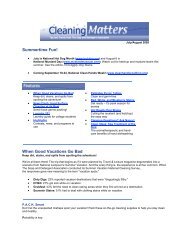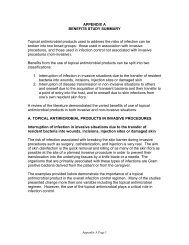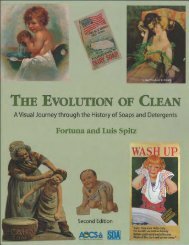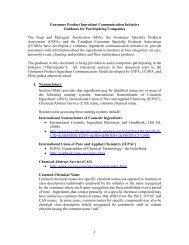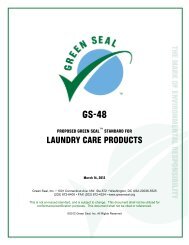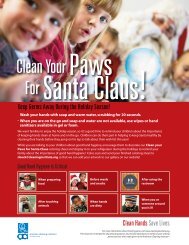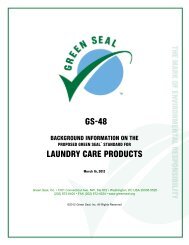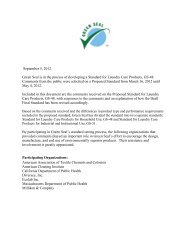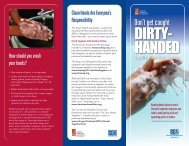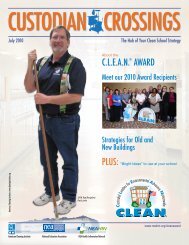subchapter c -- federal hazardous substances act regulations
subchapter c -- federal hazardous substances act regulations
subchapter c -- federal hazardous substances act regulations
You also want an ePaper? Increase the reach of your titles
YUMPU automatically turns print PDFs into web optimized ePapers that Google loves.
16 CFR Ch. II (1–1–05 Edition) – proposed modification – 6/25/06<br />
children that contains an accessible and<br />
harmful amount of a <strong>hazardous</strong> chemical is<br />
banned. 15 U.S.C. 1261(q)(1)(A). In<br />
evaluating the potential hazard associated with<br />
children’s products that contain <strong>hazardous</strong><br />
chemicals, the Commission’s staff considers<br />
certain f<strong>act</strong>ors on a case-by-case basis,<br />
including: the total amount of the <strong>hazardous</strong><br />
chemical in a product, the accessibility of the<br />
<strong>hazardous</strong> chemicals to children, the risk<br />
presented by that accessibility, the age and<br />
foreseeable behavior of the children exposed<br />
to the product, and the marketing, patterns of<br />
use, and life cycle of the product.<br />
(2) The Commission’s staff has identified a<br />
number of liquid-filled children’s products,<br />
such as rolling balls, bubble watches,<br />
necklaces, pens, paperweights, maze toys,<br />
liquid timers, and keychains, that contain<br />
<strong>hazardous</strong> chemicals. In several of these cases,<br />
the staff determined that these products<br />
violated the FHSA because they presented a<br />
risk of chemical poisoning and/or chemical<br />
pneumonia from aspiration. This determination<br />
resulted in recalls or in the replacement of<br />
those products with substitutes, as well as in<br />
agreements with the manuf<strong>act</strong>urers to<br />
discontinue the use of <strong>hazardous</strong> chemicals in<br />
liquid-filled children’s products in future<br />
production. The Commission believes that<br />
these <strong>hazardous</strong> <strong>substances</strong> pose a risk to<br />
young children and, consequently,<br />
manuf<strong>act</strong>urers should not have included them<br />
in the product design or manuf<strong>act</strong>uring<br />
process.<br />
(3) Therefore, the Commission considers<br />
the use of <strong>hazardous</strong> chemicals in children’s<br />
products such as those described above to be<br />
ill-advised and encourages manuf<strong>act</strong>urers to<br />
avoid using them in such products. Further, the<br />
Commission recommends that, before<br />
purchasing such products for resale, importers,<br />
distributors, and retailers obtain assurances<br />
from the manuf<strong>act</strong>urers that liquid-filled<br />
children’s products do not contain <strong>hazardous</strong><br />
liquid chemicals.<br />
IMPORTS<br />
§ 1500.265 Imports; definitions.<br />
For the purposes of the <strong>regulations</strong> prescribed<br />
under section 14 of the <strong>act</strong>:<br />
(a) The term owner or consignee means the<br />
person who has the rights of a consignee under<br />
-- 98 --<br />
the provisions of the Tariff Act of 1930 (secs.<br />
483, 484, 485, 46 Stat. 721 as amended; 19<br />
U.S.C. 1483, 1484, 1485).<br />
(b) The term area office director means the<br />
director of the area office of the Consumer<br />
Product Safety Commission having<br />
jurisdiction over the port of entry through<br />
which a <strong>hazardous</strong> substance is imported or<br />
offered for import, or such officer of the area<br />
office as he may designate to <strong>act</strong> in his behalf<br />
in administering and enforcing the provisions<br />
of section 14 of the <strong>act</strong>.<br />
§ 1500.266 Notice of sampling.<br />
When a sample of a <strong>hazardous</strong> substance<br />
offered for import has been requested by the<br />
director of the area office, the collector of<br />
customs having jurisdiction over the <strong>hazardous</strong><br />
substance shall give to the owner or consignee<br />
prompt notice of delivery of, or intention to<br />
deliver, such sample. Upon receipt of the<br />
notice, the owner or consignee shall hold such<br />
<strong>hazardous</strong> substance and not distribute it until<br />
further notice from the area office director or<br />
the collector of customs of the results of<br />
examination of the sample.<br />
§ 1500.267 Payment for samples.<br />
The Consumer Product Safety Commission<br />
will pay for all import samples that are found<br />
to be in compliance with the requirements of<br />
the <strong>act</strong>. Billing for reimbursement should be<br />
made by the owner or consignee to the<br />
Commission area office headquarters in the<br />
territory of which the shipment was offered for<br />
import. Payment for samples will not be made<br />
if the <strong>hazardous</strong> substance is found to be in<br />
violation of the <strong>act</strong>, even though subsequently<br />
brought into compliance under the terms of an<br />
authorization to bring the article into<br />
compliance.<br />
§ 1500.268 Hearing.<br />
(a) If it appears that the <strong>hazardous</strong><br />
substance may be subject to refusal of<br />
admission, the area office director shall give<br />
the owner or consignee a written notice to that<br />
effect, stating the reasons therefor. The notice<br />
shall specify a place and a period of time<br />
during which the owner or consignee shall<br />
have an opportunity to introduce testimony.<br />
Upon timely request, giving reasonable<br />
grounds therefor, such time and place may be<br />
changed. Such testimony shall be confined to



